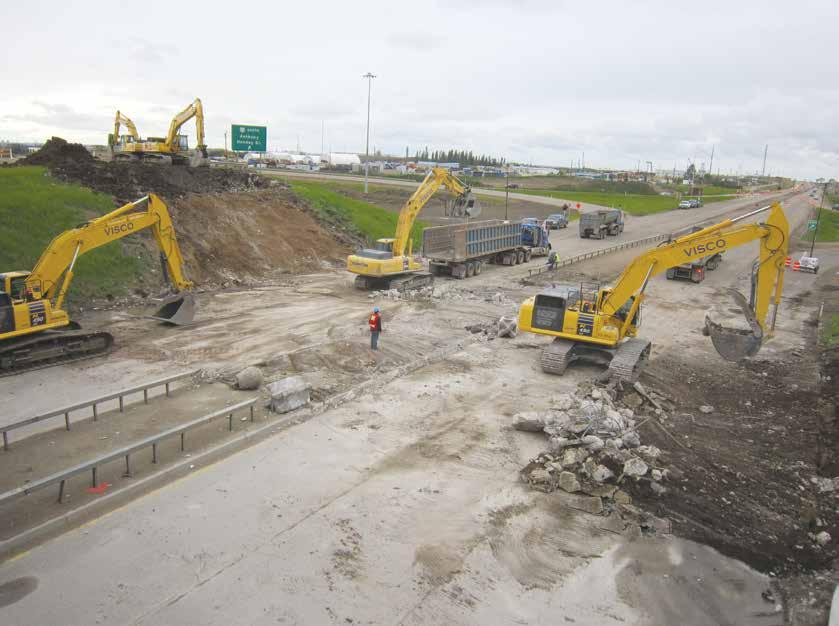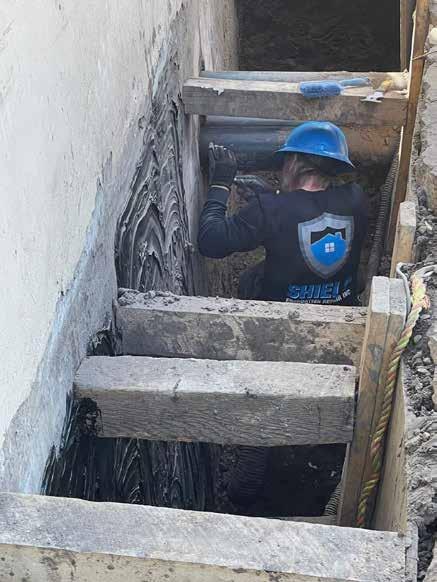
4 minute read
THE UNIVERSITY OF ALBERTA’S CONSTRUCTION INNOVATION CENTRE (CIC)

Advancing construction innovation through collaboration and high-impact research
By Ali Golabchi, PhD, PMP, Associate Director, Construction Innovation Centre (CIC)
There has historically been a disconnect between academia and industry. Just like the plans and tactics created by a contemporary Fortune 500 CEO are inevitably different from what a professor of business studies will teach to their students in the classroom, construction researchers and construction practitioners work and think on different levels. However, the construction industry needs to catch up to other industries in terms of adopting innovative solutions to address its long-lasting challenges, such as low productivity, and new ones, such as labour shortage.
The Construction Innovation Centre (CIC) was established by the Faculty of Engineering at the University of Alberta in 2019 to bridge the gap between researchers and construction practitioners and make sure that construction engineering research aligns with the concerns and interests of the construction organizations in the community. The CIC leverages the strength of its connections to the construction industry and the many construction-related disciplines that are covered under the Faculty of Engineering’s umbrella.
WHAT IS THE CIC AIMING TO ACCOMPLISH?
The CIC intends to become the foremost source for cutting-edge research and technology for Alberta’s construction industry. The combined expertise and experience of more than 30 faculty members, who are established researchers and educators, and more than 50 trusted industry partners with long histories of excellence, has created an interdisciplinary and collaborative environment for collaboration between academia, industry, and the Canadian government to come together to create high-impact innovations across the construction engineering spectrum and pioneer solutions to the most pressing problems facing the construction industry at large.



The CIC’s research endeavours are guided by its Research Roadmap, a living document that guides the CIC and the researchers who work with it to identify the most vital areas for research, provide important and impactful services to CIC members, and identify meaningful metrics to measure the performance of CIC projects. The roadmap has been developed through extensive interviews and surveys of industry practitioners, researchers, and members of governing bodies, reflecting the most prominent needs of the construction industry. The CIC’s Research Roadmap puts an emphasis on projects that are collaborative and multi-disciplinary, have significant potential to lead to academic breakthroughs, and will lead to the greatest possible impact on the construction industry at large. It also represents a continually updated blueprint for where the CIC will focus its efforts to find solutions to the big and interesting problems currently facing the construction industry.
The goal of the CIC is to advance the competitiveness of our construction industry partners, enhance and showcase the expertise of our collaborators, contribute to innovation in construction, and become internationally recognized as a leader in benefitting the construction industry and society as a whole.
WHAT ARE SOME EXAMPLES OF CIC PROJECTS?
The CIC’s projects span a variety of topics involving emerging technologies such as artificial intelligence, robotics, digital twins, and extended reality, to develop innovative solutions and technologies that can potentially solve the top challenges of the construction industry.
Example of some current CIC research projects include:
The CIC project titled “Enhancing Safety Management Systems on Construction Projects: A data-driven approach” seeks to use artificial intelligence and machine learning (AI/ ML) analysis to help identify trends and leading indicators, better design prevention and mitigation strategies, and leverage information gathered from organizations across the Canadian construction industry.

The CIC project titled “Robotic Wall Construction Using Innovative Building Blocks and Processes for Enhanced Productivity, Safety, and Sustainability” seeks to develop innovative, lightweight, robot-friendly building blocks that will facilitate modular design and additive construction. The integration of robotics, innovative materials, additive manufacturing, and lean principles will lead to an improvement in the lifespan of walls created with these new materials and stimulate improvements in the Alberta building industry.
The CIC project titled “Evaluation of impact of exoskeletons on performance and safety of construction workers” aims to evaluate the suitability of wearable robots that will assist construction workers while they perform physically demanding construction tasks, and to provide a framework for the successful adoption of this emerging technology in the operations of today’s construction organizations.
The project titled “AI-powered generative design and manufacturing for prefabricated buildings” seeks to use artificial intelligence (AI) and Building
Manitex Boom Trucks
• Potain tower cranes
• Self-erecting tower cranes
• Tadano cranes
• Magni telescopic handlers
• Kobelco crawler cranes

• Broderson carry deck cranes
• Terberg Special Vehicles
Contac Cropac Equipment: (780) 955-8862

Information Modeling (BIM) to develop AI algorithms to automate design generation and optimization, facilitate intelligent manufacturing, improve the productivity and value of design through a deeper understanding of the influence of manufacturing on design, and design and optimize generative robotic manufacturing systems for sustainable production.
The CIC project titled “Industrialization and Decarbonization of the Construction Process” aims to improve the efficiency of the offsite building construction sector; develop technologies to facilitate mechanization and automation of the offsite building construction sector; and to create a BIM-based framework to automate drafting and design for manufacturing and estimate construction-related emissions and the energy consumption of building technologies.
These projects and many more are just the beginning of what the CIC hopes to help researchers and industry partners achieve, and each opens the opportunity for the academics and construction practitioners who partner with the CIC to learn more about what is possible for the future of the construction industry, not only in Canada, but worldwide.
WHERE IS THE CIC HEADED NEXT?
While the construction industry is huge and greatly contributes to the global economy, it is one of the slowest industries to adopt emerging technologies, automation, and digitalization. The CIC is constantly working alongside researchers and industry partners to find and explore innovations in construction engineering that will help bring the construction industry into the new millennium and allow it to advance and grow to suit the needs of modern society. From the question of how to improve efficiency and productivity, to explorations of new technology and construction methods, the CIC seeks to foster innovation and creativity now and into the future.

At the Construction Innovation Centre (CIC), we work with various industry partners on innovative projects in many areas related to construction engineering. If you are interested in getting involved, feel free to reach out to us at cic@ualberta.ca. u












